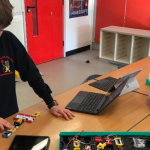What’s one thing that no child could say no to, after playing games? Making their own games, of course! And no, not just in the sense of “making up” games with their imagination, but actual playable video games.
You may think to yourself, “how can kids make a video game?! I can barely get them to tidy up their room.” But with the right tools and guidance, children are perfectly capable of developing simple games. In fact, starting early can help them gain the abilities they can later develop into advanced hard skills for programming and coding.
For kids, game making may not necessarily mean coding a game from scratch–rather, it’s about learning to code a game with Scratch. (Keep reading to find out what that means!)
What is game development and coding for children?
Game development is the general name given to the processes involved in creating a game–design, iteration, building, coding, programming, and testing. Of course, coding and game programming for kids look a little different from the work of a professional in the industry. (Though, getting started in game development at an early age can definitely pave the way for a professional career later in life!)
There are learning tools for kids specifically designed for their ages, teaching the necessary skills in a fun and simple way. Kids get to learn game development basics such as mechanics, design, reward system, and engagement while having fun. It also makes learning about basic coding concepts such as conditions and loops very easy and effective.
What is the importance of game development for children?
Game development for kids can be a great way to hone a variety of 21st-century skills. The potential skills that they can develop range from those related to analytical thinking such as problem-solving, decision-making, logical reasoning, design thinking, storytelling, to technological hard skills such as coding and programming. These skills not only prepare children for future jobs but also give them a competitive advantage throughout their education and work life.
Technology is very much embedded in our daily lives, and will increasingly continue to do so. Through engaging with game development, kids can understand the world around them and how it works much better.
In addition to these specific learning outcomes, game development is an incredible means for children to create and accomplish a project that interests them. Children are already invested in all kinds of games and fascinated by how parts come to make a functioning whole.
Think of the simplicity of LEGO building blocks. Yet children (even adults!) from all sorts of backgrounds and interests spend hours and days playing with these simple toys–building, breaking, rebuilding, imagining, re-imagining, designing, and executing.
Game designing for kids offers a very similar process of creative exploration. In the end, the little ones can look back at their creation, be proud of their accomplishment and keep playing around with it.
What are the stages of game development for kids?
The stages of game development can be roughly grouped into five: ideation, creation, testing, release, and post-release.
In the ideation stage, the developer picks and develops their concept and gathers as much information about it as possible. What kind of game is planned? What is the target audience? What is the main storyline? How will the game develop and unfurl as the player proceeds? A rough outline of the game and its elements is thought up.
The second stage, which is creation, is perhaps the longest one. This is where the game is refined, the characters and environment are really fleshed out. The game is coded, designed, and the narrative is written out. Ultimately, it all depends on what kind of game is being built.
For kids, game programming and creation mostly occur through block coding and/or other game development tools. This makes the creation stage a little simpler and more straightforward so that the little minds don’t wander off too much and get lost in the process.
The next stage of game development is testing. This is where the created game undergoes tests to detect any errors and bugs. In addition to the technicalities, the concepts and elements in the game, such as character development and narrative elements, can be furthered and fine-tuned in this stage.
After testing comes the release, which is the fourth stage of a usual game development cycle. Of course, this only applies to commercial game development projects. If the game is designed for your own pleasure, this stage will only consist of sharing with friends and family as you wish. Otherwise, you would want to invest some time and effort in marketing the finished product to the larger public on various platforms.
Game development is a circular process, so it is not over until you say it’s over! There’s always room for more updates, improvements, and changes. This is what the post-release stage consists of. As new ideas crop up, they are developed, created, and put to test, following the stages of game development.
How can kids get started at game development?
Kids can get started at game development as early as at the age of three. However, how to engage them with coding and development would depend on their age range and needs. For example, between the ages of three and seven, the learning process should be focused more on the fun and games part. The technical training on coding skills can be gradually eased into after the age of seven.
The first step to becoming a good game developer is being a good gamer! That’s right. Just as it takes a good reader to become a good writer, it takes a good gamer to become a good game developer. So, a great place to start is playing games with a critical lens. As they’re playing, invite them to think about what they like and what they don’t like. What are the strengths and weaknesses? How good is the game, and why? What would they improve if they could?
Then they can test the waters of game development by editing games that already exist. Starting out with games that they are familiar with, such as Minecraft and Roblox, will be a good way to get acquainted with editing tools and techniques.
Finally, they can get into coding and game development through block-based platforms and apps specifically geared at teaching game coding for kids. MIT’s visual-based coding editor Scratch helps children create fun animations, interactive stories, games, and sounds.
For a comprehensive start at coding and game development, you can check out Twin App’s interactive coding games for kids. With over 1000 projects, coding lessons from a professional software engineer, and gamified coding projects, children can not only learn to develop their own games but also learn the basics of block coding. You can also get the Twin Coding Kit or the Autonomous Vehicle Kit for a more hands-on learning experience!
Overall, with game development for kids, the goal is to develop skills and have fun doing it. Just like for all other DIY crafts and games that you create together with your child, you should embrace imperfections – even encourage making mistakes! In the end, game development is a cyclical, never-ending process of trial and error, discovery and (re)invention.




